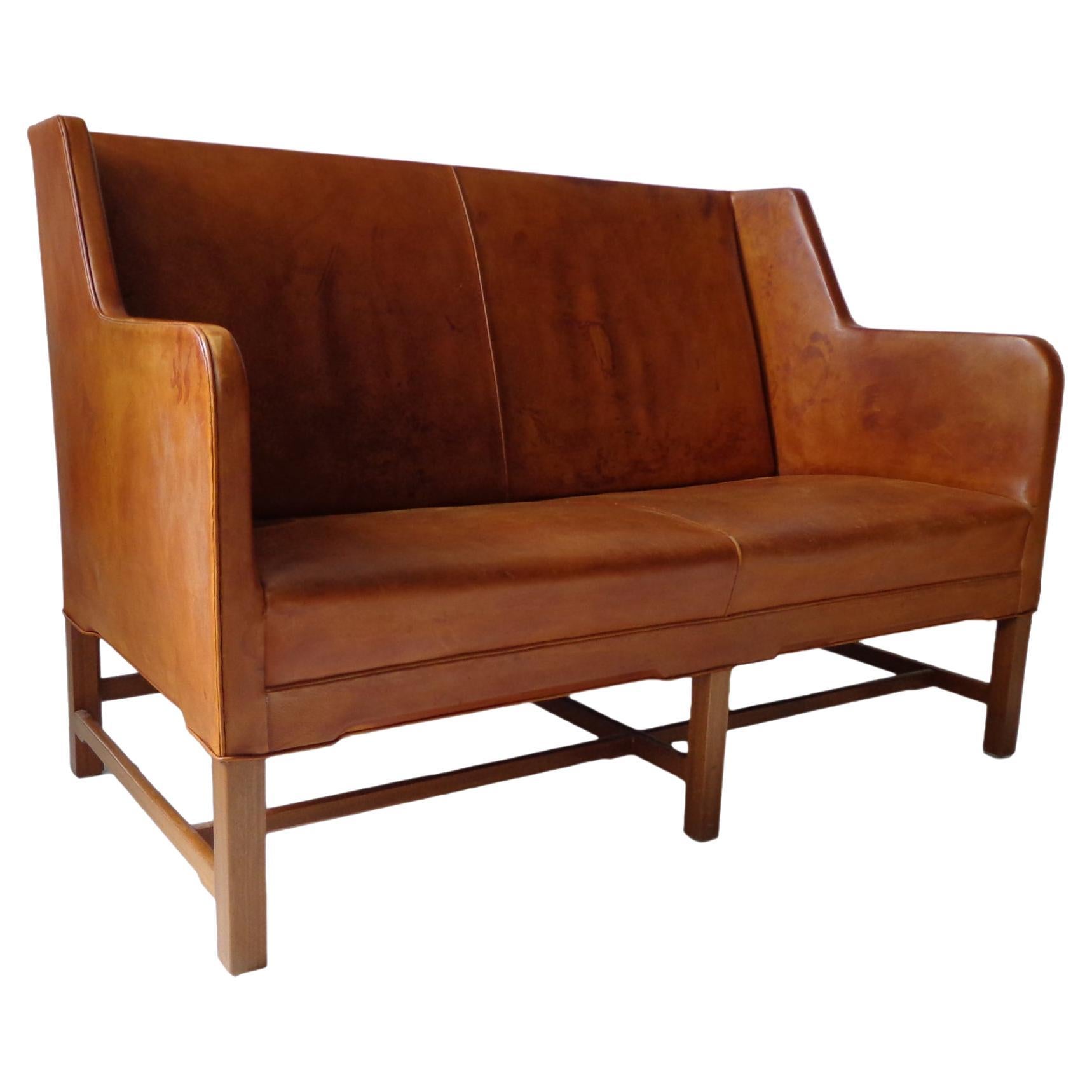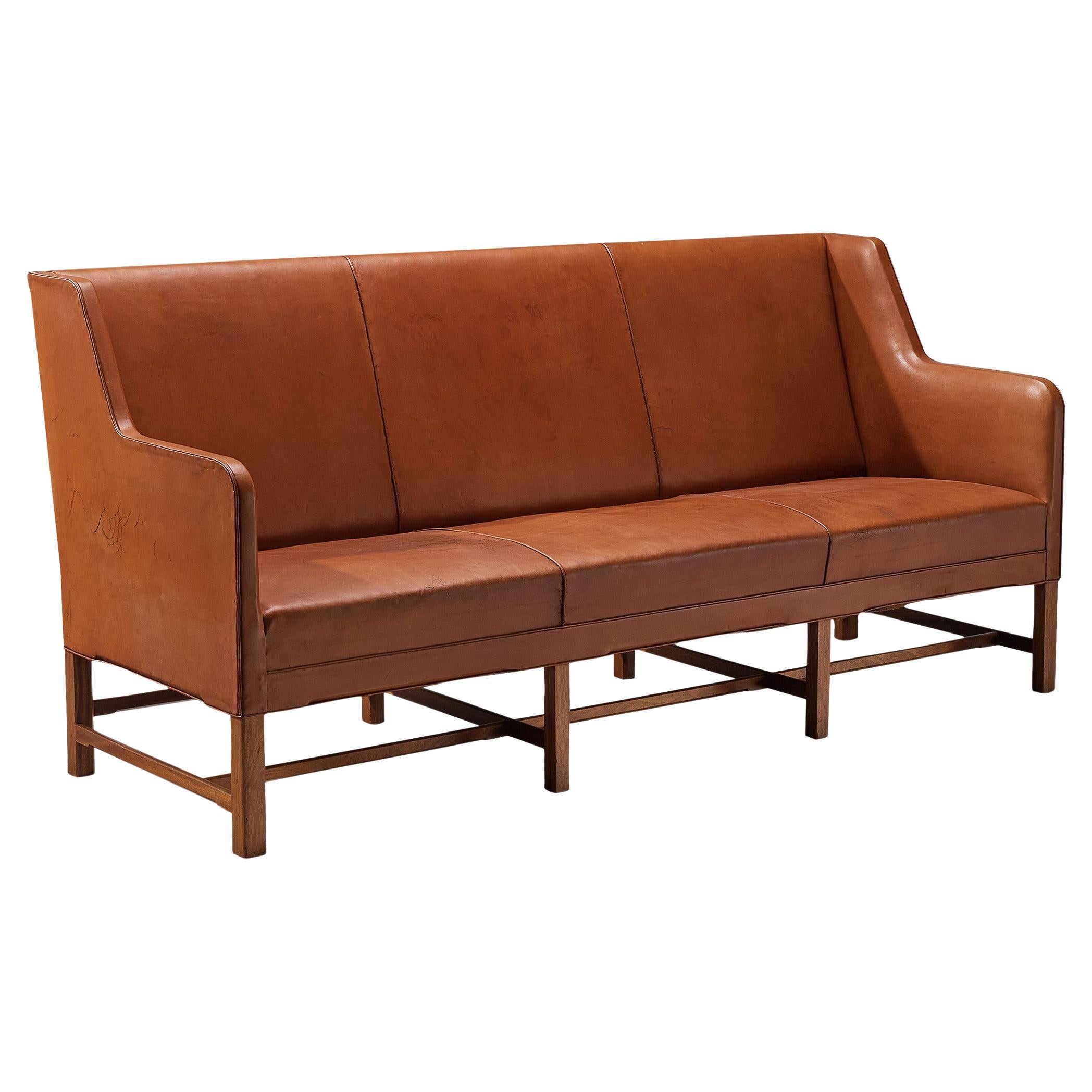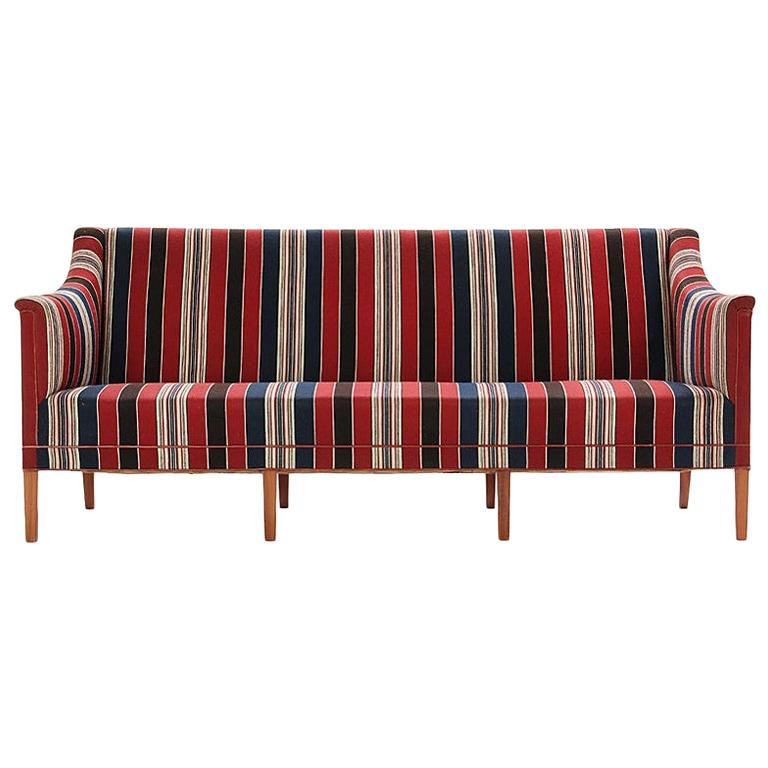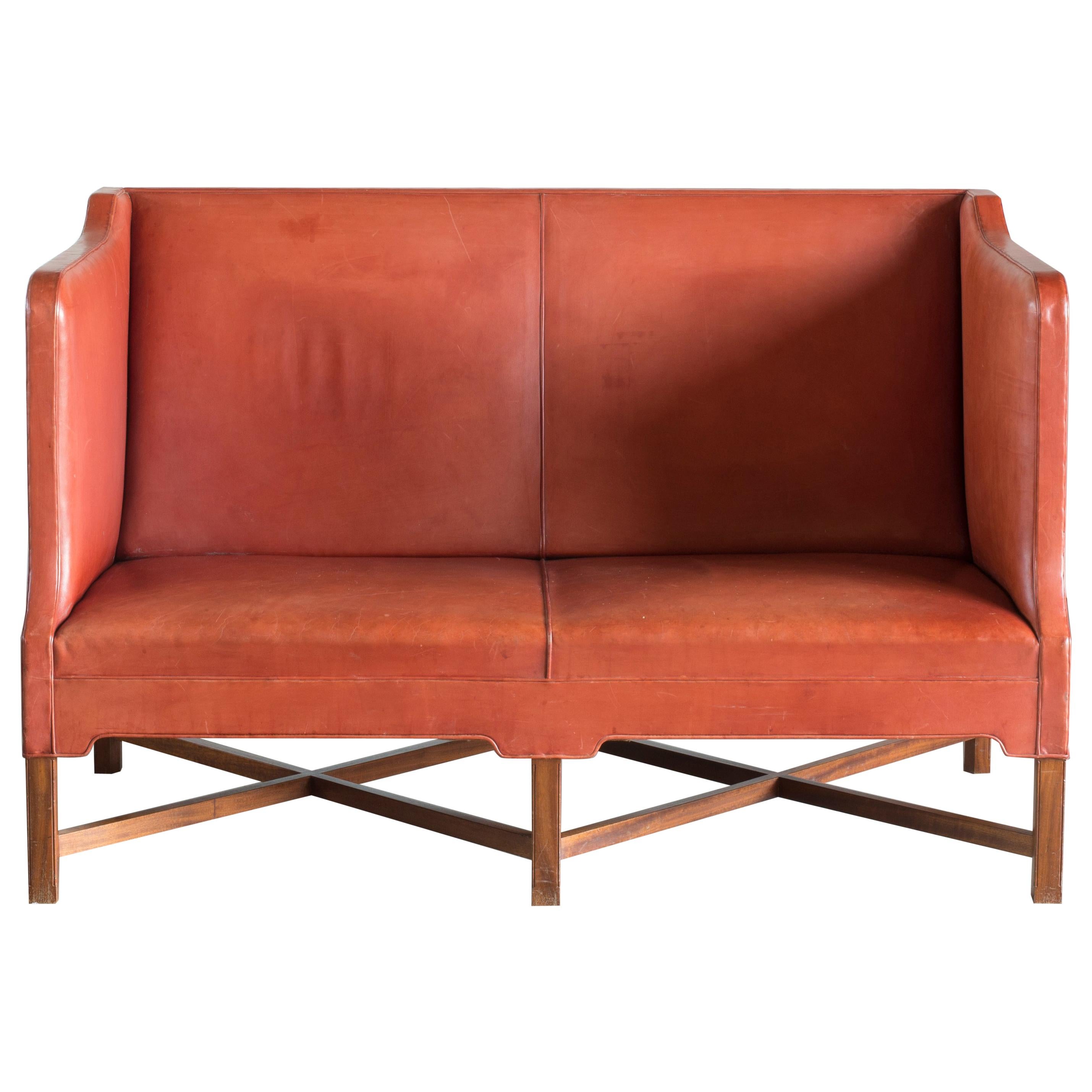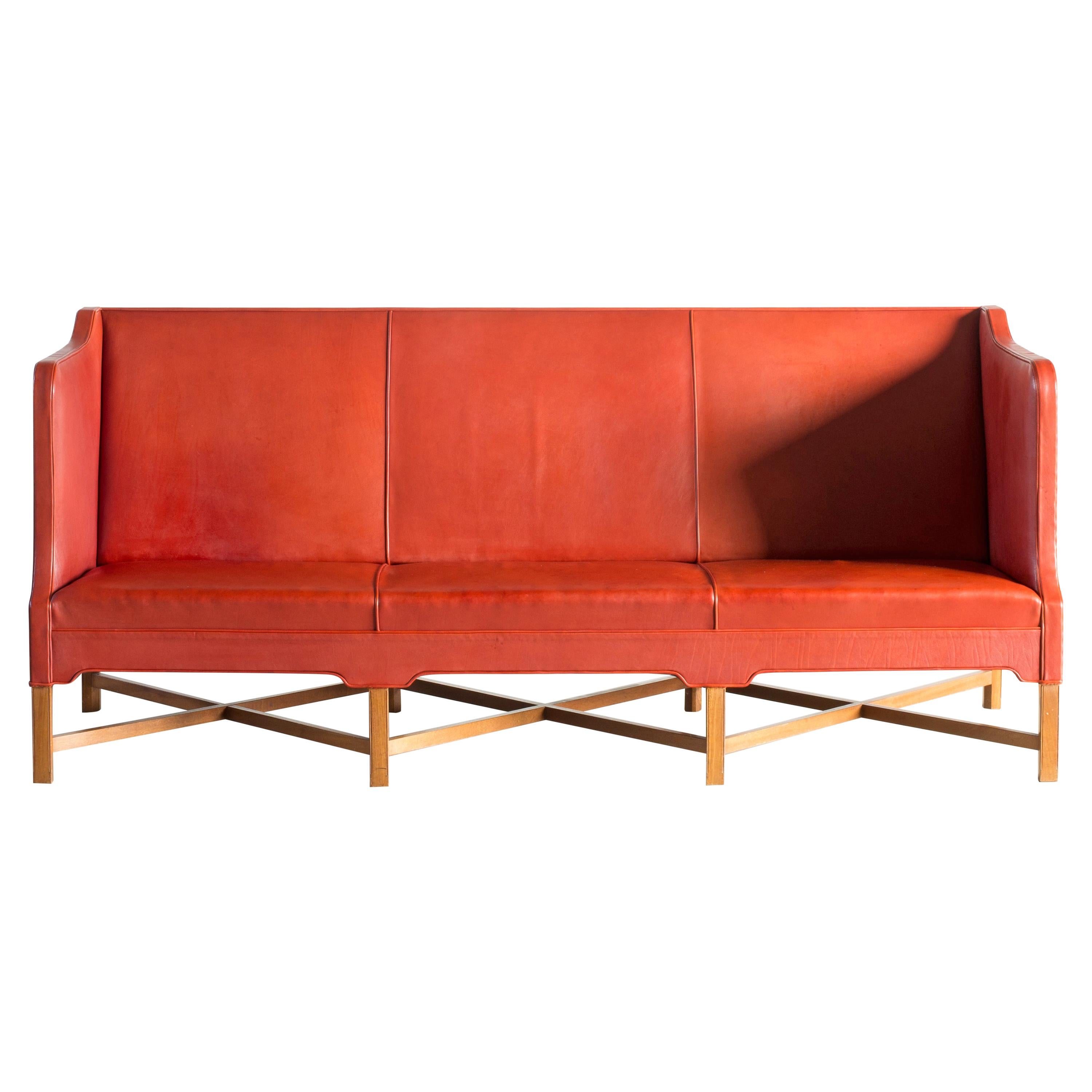Kaare Klint Sofa Model 5011 Original Cognac Leather for Rud Rasmussen Denmark
About the Item
- Creator:Kaare Klint (Designer),Rud Rasmussen (Cabinetmaker)
- Dimensions:Height: 35.83 in (91 cm)Width: 77.17 in (196 cm)Depth: 31.11 in (79 cm)Seat Height: 16.15 in (41 cm)
- Style:Scandinavian Modern (Of the Period)
- Materials and Techniques:
- Place of Origin:
- Period:
- Date of Manufacture:1970s
- Condition:
- Seller Location:WIJCKEL, NL
- Reference Number:1stDibs: LU8306233167252
Kaare Klint
Architect, teacher and furniture designer Kaare Klint is among the most important figures in Scandinavian modernism. Widely recognized as the father of modern Danish furniture, Klint sought to pay homage to historical furniture styles and prized functionality as essential to designing for modern living. He established the design school at Copenhagen’s Royal Danish Academy of Fine Arts, and his students became mid-century legends of cabinetry and furniture-making.
Klint prioritized functionalism and drew on an array of influences in his own work. Furniture experts will observe the influence of 18th-century English seating in his Red chair, while Klint’s iconic Safari chair had roots in campaign furniture. The other exemplary chairs, sofas and tables for which he is known bear the mark of Thomas Chippendale and Biedermeier furniture as well as Greek and Roman forms.
Klint's father was Peder Vilhelm Jensen-Klint, a formidable architect of his day. The younger Klint initially followed in his father’s footsteps, studying under him as well as distinguished architect Carl Petersen. Alongside Danish architect Ivar Bentsen, he headed the renovation of the Designmuseum Denmark in Copenhagen from 1920–26 (Klint also furnished the institution as part of the project). Around the same time, Klint helped found the furniture design school at the Royal Danish Academy. The impact of his role as an instructor there cannot be overstated — he mentored such esteemed cabinetmakers and furniture designers as Børge Mogensen, Hans Wegner and Ole Wanscher.
A prominent advocate of ergonomics, Klint valued comfort and functionality over style. Painstaking research went into each piece of sophisticated yet wholly unadorned furniture he designed, as he endeavored to build structures that took into consideration human proportions and scale. And like the Shakers, Klint believed that quality craftsmanship and good materials were integral to the design of durable furniture that was free of embellishment.
The humble grace of Klint’s style characterizes legendary seating designs that continue to charm today’s legions of mid-century modern enthusiasts. His Safari chair, Faaborg chair, Ravenna armchair and Propeller stool — as well as most of the seating created by Danish modernists generally — have warmed interiors and influenced furniture designers all over the world.
Find vintage Kaare Klint furniture and other Scandinavian modern furniture on 1stDibs.
Rud Rasmussen
Exemplary designs for wood chairs, cabinets, desks and tables are part of the legacy associated with Rud Rasmussen, an iconic Danish furniture manufacturer that collaborated with some of the world’s best known and universally revered Scandinavian modernists.
Rud Rasmussen Snedkerier was established in 1869 in Copenhagen. The workshop’s founder, cabinetmaker Rudolph Rasmussen, was raised in a family of carpenters and had initially specialized in oak furniture. It wasn’t long before the business had grown — in 1876, Rasmussen was operating out of a four-storey factory, and by the end of the 19th century, the manufacturer had forged relationships with esteemed Danish architects including Vilhelm Dahlerup and Thorvald Bindesbøll.
With Rudolph Rasmussen's passing in 1904, the founder’s sons, Rudolph and Victor, took control of the company. They realized their father's dream of expanding the business — the firm had by then been accepting commissions from Copenhagen City Hall and was soon producing furniture for the likes of the police station, the postal service, ministries, technical universities and hospitals. More longstanding collaborations with legendary cabinetmakers and architects came into play, too.
Rud Rasmussen partnered with Mogens Koch, Børge Mogensen, Hans Wegner and Kaare Klint, the founder of the design school at Copenhagen’s Royal Danish Academy of Fine Arts. The manufacturer is known to collectors for producing Koch’s versatile bookcases, and, in 1933, Rud Rasmussen debuted Klint’s Safari chair — a clever and timeless interpretation of campaign furniture.
Carl Hansen and Søn acquired Rud Rasmussen in 2011.
Find vintage Rud Rasmussen seating, case pieces and decorative objects on 1stDibs.
- ShippingRetrieving quote...Ships From: WIJCKEL, Netherlands
- Return PolicyA return for this item may be initiated within 3 days of delivery.
- Kaare Klint Sofa Model 5011 in Original Cognac Leather Rud Rasmussen, DenmarkBy Rud Rasmussen, Kaare KlintLocated in WIJCKEL, NLTwo-seater sofa model 5011 in original cognac leather and six-legged mahogany base. Produced by Rud. Rasmussen Cabinetmakers, Denmark. Minor marks on the frame, patina to the leather. Back covered in original canvas. Shown at the Copenhagen Cabinetmakers’ Guild exhibition in 1935. Signed with decal manufacturer’s label to underside: (Rud. Rasmussens Snedkerier). Kaare Klint is widely recognized as the father of Danish modern design. It is hard to overstate his influence. He developed an entirely new analytical approach to furniture design that his students at the Danish Academy of Art would emulate for years to come, yet was also inspired by historic designs from various cultures, modernizing and re-interpreting classic pieces for new generations. Literature: Gorm Harkær, Klintiana: “Kaare Klint”, vol.2, pg 94. Kaare Klint (1888-1954) is regarded as the founding father of Danish Modernim. As an architect, furniture designer and leading professor at the Department of Furniture Design at the Royal Danish Academy of Fine Arts, Copenhagen, Klint established the principles of modern Danish furniture by combining a profound appreciation of traditional construction techniques with a modernist emphasis on function and a rejection of ornaments. Klint’s design was always based on relentless research; he never compromised. Every piece had to fulfill its purpose, be completely clear in its construction with dimensions and proportions corresponding to the human body and display materials and craftsmanship of the highest quality. Logic, often using a mathematical system of measures, and a constructive way of thinking were the foundation of Klint’s philosophy of furniture design. Like many of his contemporaries, counting Le Corbusier and Walter Gropius, he advocated standardization and functional requirements and dismissed the use of all ornamentation. But Klint realized his vision in wood and leather, using traditional craftsmen and working methods and often finding inspiration in historical models. In this way, he charted the course for an alternative Nordic Functionalism that idealized the workshop and the collaboration between furniture architects and cabinetmakers as opposed to the factory. Kaare Klint’s first major work was a collaboration with his mentor, the architect Carl Petersen. In 1914 they were commissioned to design furniture and fixtures for Faaborg Art Museum. One of the highlights to emerge from this commission was the Faaborg chair, a light and elegant chair with clear references to classical furniture. The construction and proportions of an 18th century English Chippendale chair...Category
Vintage 1940s Danish Scandinavian Modern Sofas
MaterialsLeather, Mahogany
- Kaare Klint Armchair Model 3758a in Leather and Mahogany Rud Rasmussen DenmarkBy Kaare Klint, Rud RasmussenLocated in WIJCKEL, NLArmchair model 3758 A in original red indian leather and mahogany base. Model designed in 1927 for the Danish Museum of Decorative Art, produced by Rud Rasmussen in the 1940’s. Signed with manufacturer’s label to underside: (Rud. Rasmussens Snedkerier). Kaare Klint is widely recognized as the father of Danish modern design. It is hard to overstate his influence. He developed an entirely new analytical approach to furniture design that his students at the Danish Academy of Art would emulate for years to come, yet was also inspired by historic designs from various cultures, modernizing and re-interpreting classic pieces for new generations. Literature: Kaare Klint, Harkær, pg. 28-30. Dansk Møbelkunst Gennem 40 Aar: 1927-1936, Jalk, pg. 169. Danish Chairs, Oda, pg. 22-23. Kaare Klint (1888-1954) is regarded as the founding father of Danish Modernim. As an architect, furniture designer and leading professor at the Department of Furniture Design at the Royal Danish Academy of Fine Arts, Copenhagen, Klint established the principles of modern Danish furniture by combining a profound appreciation of traditional construction techniques with a modernist emphasis on function and a rejection of ornaments. Klint’s design was always based on relentless research; he never compromised. Every piece had to fulfill its purpose, be completely clear in its construction with dimensions and proportions corresponding to the human body and display materials and craftsmanship of the highest quality. Logic, often using a mathematical system of measures, and a constructive way of thinking were the foundation of Klint’s philosophy of furniture design. Like many of his contemporaries, counting Le Corbusier and Walter Gropius, he advocated standardization and functional requirements and dismissed the use of all ornamentation. But Klint realized his vision in wood and leather, using traditional craftsmen and working methods and often finding inspiration in historical models. In this way, he charted the course for an alternative Nordic Functionalism that idealized the workshop and the collaboration between furniture architects and cabinetmakers as opposed to the factory. Kaare Klint’s first major work was a collaboration with his mentor, the architect Carl Petersen. In 1914 they were commissioned to design furniture and fixtures for Faaborg Art Museum. One of the highlights to emerge from this commission was the Faaborg chair, a light and elegant chair with clear references to classical furniture. The construction and proportions of an 18th century English Chippendale...Category
Vintage 1950s Danish Scandinavian Modern Armchairs
MaterialsLeather, Mahogany
- Fritz Hansen Furniture poster for Arne Jacobsen models butterfly chair DanishBy Arne Jacobsen, Fritz HansenLocated in WIJCKEL, NLHere is a very rare and desirable Furniture poster by the Danish designer Arne Jacobsen for Fritz Hansen representing the serie 7 chair or butterfly chair in a variety of different c...Category
20th Century Danish Scandinavian Modern Posters
MaterialsPaper
- Jo Hammerborg Table Lamp Model Senior Produced by Fog & Mørup in DenmarkBy Fog & Mørup, Jo HammerborgLocated in WIJCKEL, NLRare table lamp model Senior designed by Jo Hammerborg. Produced by Fog & Mørup in Denmark. Satin aluminium, black lacquerd and chrome base, glass lilla lampshade exterior, opal whi...Category
Vintage 1960s Danish Scandinavian Modern Table Lamps
MaterialsAluminum, Stainless Steel
- Hans Wegner white Opala Pendant for Louis Poulsen DenmarkBy Louis Poulsen, Hans J. WegnerLocated in WIJCKEL, NLThis largeset pendant-chandelier lamp has a top in grey lacquered metal and high gloss acryl shade opal. The maximum bulb is 200W. Marked inside by Louis Poulsen. The Opala lamp...Category
Vintage 1970s Danish Scandinavian Modern Chandeliers and Pendants
MaterialsMetal
- Verner Panton Peacock Lounge Chair for Plus-Linje Denmark MidcenturyBy Verner Panton, Plus-LinjeLocated in WIJCKEL, NLConsisting of a bowl shaped top and a cylindrical foot made from electrogalvanized stainless steel wire. The two parts are connectable with clips for a floor standing version. The bowl shaped top can be used separately and hung from the ceiling. The chair has 7 removable original seat cushions upholstered in grey woolen fabric. Literature: Cara Greenberg, Op to Pop, New York, 1999, pp. 116 and 126 Alexander von Vegesack, Mathias Remmele, eds. Verner Panton: The Collected Works, exh. cat., Vitra Design Museum, Weil am Rhein, 2000, pp. 9 and 246 Charlotte and Peter Fiell, 60s Decorative Arts, Cologne, 2000, p. 18. A danish designer and architect who lives in Switserland, Verner Panton has worked in many areas and with many manufacturers, providing numerous designs. Verner Panton studied at the Royal Danish Academy in Copenhagen and worked as an associate with Arne Jacobsen. He opened his own design office in 1955 and created the first single-form injection molded plastic chair in 1960, edited by Herman Miller in 1967. He created truly innovative futuristic furniture...Category
Vintage 1960s Danish Scandinavian Modern Lounge Chairs
MaterialsSteel
- Kaare Klint for Rud Rasmussen Sofa in Original Cognac LeatherBy Kaare Klint, Rud RasmussenLocated in Waalwijk, NLKaare Klint for Rud Rasmussen, sofa model '5011', leather, wood, Denmark, design 1935. Classic and elegant Scandinavian three-seat sofa by Kaare Klint designed in 1935. The high bac...Category
Vintage 1930s Danish Scandinavian Modern Sofas
MaterialsLeather, Wood
- 1960s Danish Sculpted Sofa by Kaare Klint for Rud RasmussenBy Kaare Klint, Rud RasmussenLocated in Sagaponack, NYA majestic sofa having a sculptured body resting on eight (8) tapered mahogany legs, retaining the original red, navy and beige striped wool fabric. Desi...Category
Vintage 1940s Danish Scandinavian Modern Sofas
MaterialsUpholstery, Mahogany
- Kaare Klint Two-Seat Sofa for Rud. RasmussenBy Kaare Klint, Rud RasmussenLocated in Copenhagen, DKKaare Klint freestanding two-seat sofa on six-legged, profiled mahogany cross-frame. Sides, seat and back upholstered with patinated leather. Executed by Rud. Rasmussen, Copenhagen. ...Category
Mid-20th Century Danish Scandinavian Modern Sofas
MaterialsLeather, Mahogany
- Kaare Klint Three-Seat Sofa for Rud. RasmussenBy Kaare Klint, Rud RasmussenLocated in Copenhagen, DKKaare Klint. A three-seat sofa with mahogany legs, seat, sides and back with blue-, red- and whitestriped Greek Savak. Executed by Rud. Rasmussen, Copenhagen.Category
Mid-20th Century Danish Scandinavian Modern Sofas
MaterialsMahogany, Wool
- Kaare Klint Three-Seat Sofa for Rud. RasmussenBy Kaare Klint, Rud RasmussenLocated in Copenhagen, DKKaare Klint freestanding three-seat sofa on eight-legged, profiled mahogany cross-frame. Sides, seat and back upholstered with patinated red leather. Model 4118. Executed by Rud. Ras...Category
Mid-20th Century Danish Scandinavian Modern Sofas
MaterialsLeather, Mahogany
- Kaare Klint Three-Seat Sofa for Rud. RasmussenBy Rud Rasmussen, Kaare KlintLocated in Copenhagen, DKKaare Klint three seat sofa with eight legs of Mahogany. Seat, sides and back upholstered with blue, red and white striped "Savak" wool, niger leather edgings. Executed by Rud. Rasmu...Category
Mid-20th Century Danish Scandinavian Modern Sofas
MaterialsMahogany, Leather, Wool
